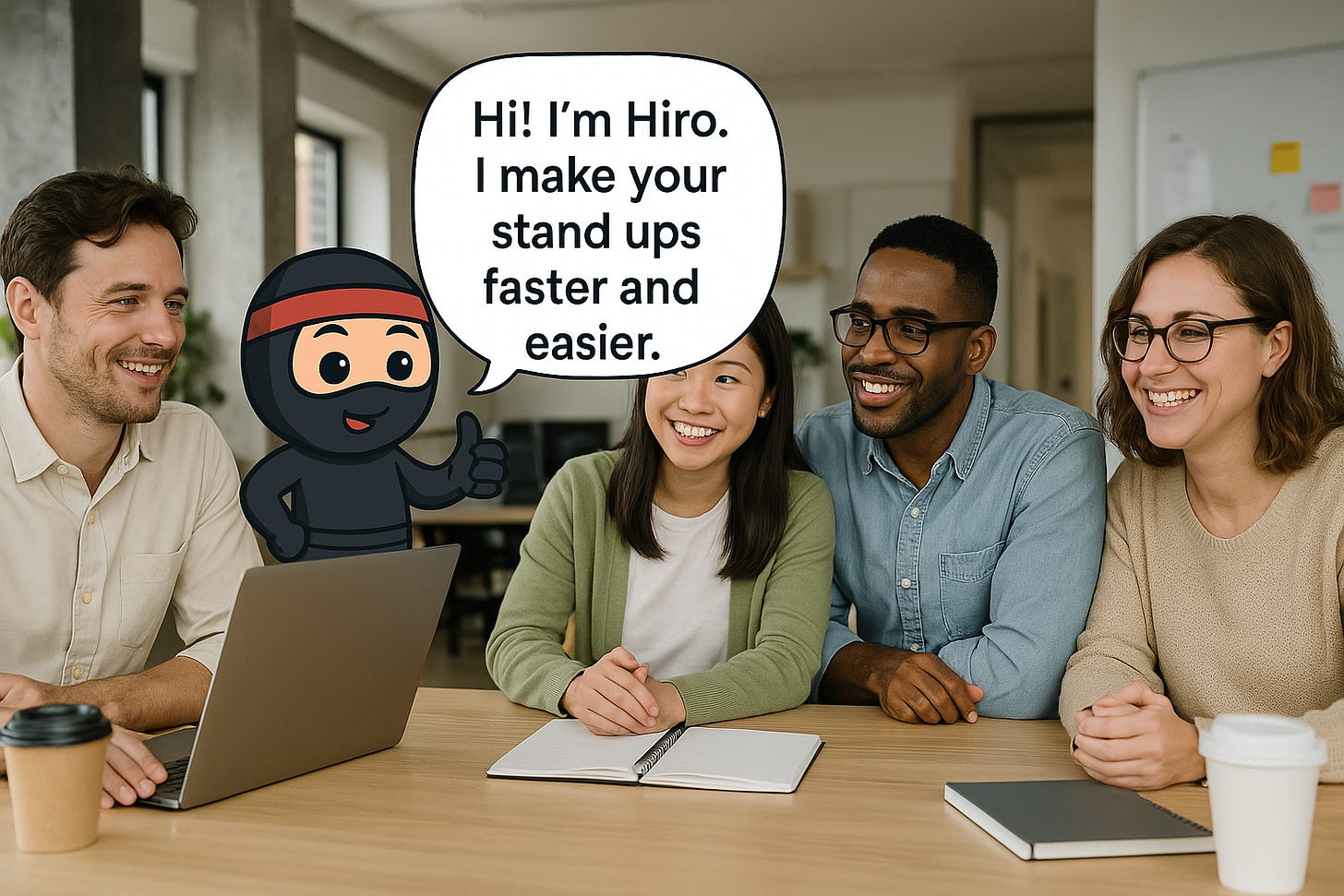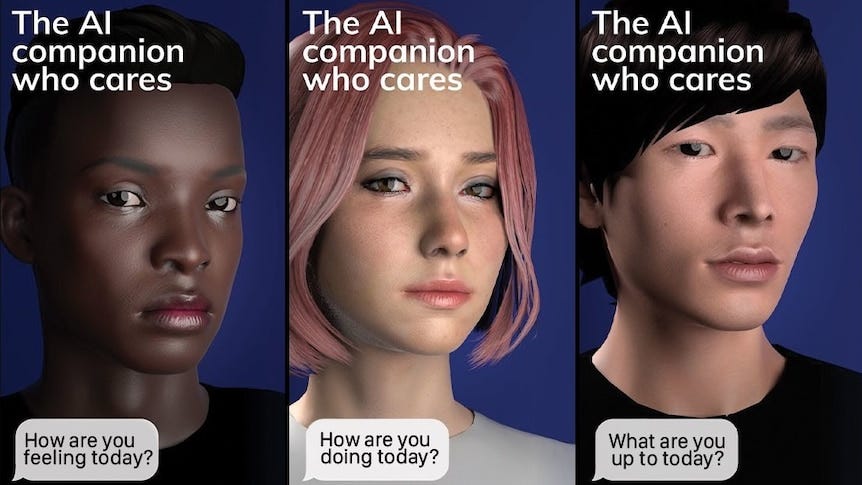Personality by Design: Why Voice AI Teammates Need Character
As AI agents move from being tools to teammates, one thing becomes clear: a good AI partner needs more than skills – it needs a personality.
As we continue building voice agents at Hiro’s Studio, we have started to cross into some wild territory…
Last month we set out to build an AI agent that would work alongside humans. The agent, designed to streamline internal communications, had a problem. It worked well but it didn’t feel right. Users could share status updates, but they weren’t natural. We wanted something more stream-of-thought — something you could use while commuting or cooking dinner. It just didn’t feel human enough. This article is about how we solved that problem and what we learned along the way.
Becoming human
We’ve all seen chatbots evolve, from “press 1 to speak English” days through more flat, utilitarian chatbots “Thanks for calling Capital One, please state how we can help” and then voice assistants with a bit of charm (Hey Siri, tell me a joke). Each step felt progressively more human.
That “human touch” isn’t just fluff; studies in human-computer interaction (HCI) show that people instinctively project personality onto AI and respond to it socially. In fact, when a computer’s synthetic voice carries personality cues – its tone, pitch, pace – users will attribute traits like extroversion or introversion to it, even knowing it’s a machine. And here’s the kicker: when that voice’s personality matches the user’s own style, the user likes it more and is more readily influenced by it. In other words, we humans are wired to seek rapport, even with our algorithms.

Soft skills build trust. Just as you’d trust a coworker who is polite, empathetic, and consistent, we come to trust AI that demonstrates social savvy. Researchers have found that an AI’s demeanor – whether it’s friendly or curt, playful or serious – directly affects how people engage with it. For example, one experiment by researchers at Cornell showed that an “extroverted” virtual assistant (speaking in an upbeat, lively tone) was preferred and trusted more than an “introverted” one for a café greeter role. The extrovert voice made people feel more at ease, regardless of their own personality. An agent with the right personality can put us in the comfort zone where we communicate openly and rely on its assistance. On the flip side, a mismatched personality – say, a drill-sergeant tone for a home assistant – can alienate users and erode trust, even if the AI’s raw capabilities are top-notch.
Chatbots vs. Embodied Agents: Bridging the Emotional Gap
In looking at human-AI collaboration, we’ve observed a key difference that I think is worth spelling out: Text-based chatbots vs voice/video-based agents
Let’s explore Text-based chatbots and voice/video-based agents. Both are helpful, but they occupy very different emotional spaces. If you’ve chatted with a text bot, you know the interaction stays on the intellectual surface – you read plain words on a screen. There’s relatively little warmth, and personality has to come through word choice or emojis. Now compare that to interacting with a voice assistant or a robot: the sound of a voice, its rhythm, even an on-screen avatar’s expressions, create a richer social presence. It feels more like someone is there. Psychological research calls this the “persona effect,” where an embodied agent (with voice or visuals) makes the experience more engaging and personal. We see this in virtual tutors that use cartoon avatars – students report greater connection and motivation simply because the agent seems human.
The takeaway: designing an AI’s persona isn’t cosmetic, it’s foundational to effective human-AI collaboration.
Crucially, voice is an emotional bridge. Tone of voice conveys affect – a soothing voice vs. an excited one can completely change how a message is received. A simple “I’ve scheduled your meeting” can feel either courteous or brusque depending on the tone. This emotional layer is largely absent in text. Design choices like giving an AI a cheerful intonation or a calm, confident pace help signal its “mood” and intentions. That, in turn, shapes the user’s emotional state. A recent study even suggests our brains react differently to hearing AI voices than reading text, indicating that voice-based agents engage us in more social and intuitive ways. In practical terms, a voice-based AI with a well-crafted personality can build a kind of rapport – the same way hearing a friendly customer service rep can put you at ease faster than a text chat ever could.
It’s also about embodiment. Consider how we treat disembodied chat vs. an AI that shows a face (even a cartoon face) on screen. We’re more likely to say “please” or feel bad for an embodied agent. (Anyone who’s felt a pang of guilt telling a robot vacuum to stop can relate.) The embodiment – through voice, avatar, or a physical robot – triggers our social instincts. Designers of social robots know this: a robot that makes eye contact, uses gestures, or speaks in a relatable voice can engender empathy and trust much more effectively than a faceless text interface. This is why the next generation of AI collaborators, from VR assistants to home robots, invest heavily in persona design. The emotional and relational bandwidth is simply greater when an agent has a voice and body. We start interacting not just with a database of answers, but with an apparent character.
The Personality Spectrum: From Predefined to Personalized
When Apple introduced Siri, it didn’t just read your calendar or answer queries—it had attitude. Apple’s designers gave it a warm but cheeky persona, dropping pop culture references and clever comebacks like “I’m sorry, I can’t do that, Dave.” These weren’t just gimmicks; they were a deliberate strategy to make talking to your phone feel less mechanical and more social. And it worked—for a while. Siri’s charm generated headlines and memes, and users began treating it more like a quirky digital friend than a tool.
But as expectations for intelligence rose, Siri started to feel hollow. It sounded human, but couldn’t act human. The emotional cues suggested depth, but the functionality lagged behind, creating an awkward mismatch. That’s the risk with predefined personalities: if the AI can’t meet the emotional contract it sets, users feel let down.
Replika, on the other hand, flipped the model. Instead of giving every user the same personality, it let users design their own. Replika is an AI companion app where you can name your bot, tweak its traits (funny, empathetic, serious), and even define the relationship—friend, coach, partner, or something more. This customization created a sense of ownership and intimacy that resonated with millions. People weren’t just using Replika for answers—they were forming emotional bonds. Some even considered their Replika a life partner.
But that intimacy cut both ways. When the company pulled back on some of the AI’s flirtatious features in 2023, users reported grief, disorientation, even heartbreak. It exposed something powerful: personality isn’t a nice-to-have in AI—it’s core to user trust and emotional connection. And if you violate that bond, it feels like a betrayal, not a bug.
Perhaps the problem with Siri was indeed that it sounded too much like a human but failed to pass even the minimum level of intelligence and functionality expected by the interface, creating a cognitive dissonance of sorts.
Designing “Hiro”: An AI Teammate with Personality
That insight shaped how we built Standup Hiro, our voice-based assistant for daily standup meetings. We weren’t designing a bot to transcribe updates—we were designing a teammate. One who sets the tone, models good etiquette, and actually makes the process of updating your team feel better. We took everything we learned from Siri’s charm and Replika’s intimacy and asked: how do we make personality intentional, useful, and trustworthy?

Here’s how we did it:
A Name with Character: We gave our agent a human name, Hiro. Why? Because a name signals identity. It’s easier to bond with “Hiro” than with “Standup Bot v2.0.” A name makes the interaction personal – you’re talking to someone, not something. (Psychologically, this is known to encourage anthropomorphism; even in the workplace, people are more likely to engage an AI if it has a persona and name.)
Voice : Instead of a default robotic voice, we hand-picked a voice actor profile for Hiro that matched the vibe we wanted – warm, upbeat, and slightly informal. We explored different accents to give Hiro a distinctive flair., including a Japanese accent, but settled on Canadian - warm and friendly.
Tone : The goal was a voice that sounds like a friendly colleague from another office, not a cold AI. Tone-wise, Hiro speaks with enthusiasm when celebrating team wins (“Great job on closing that ticket!”), and with calm concern when flagging a blocker. By modulating tone, Hiro can encourage and empathize just as a human team lead might.
Behavioral Quirks: To avoid Hiro feeling too sterile, we injected light humor and quirks. For example, Hiro might reply to your update with a cheery quip (“I’m glad you’ve got that under control - sounds tough”) or use a bit of playful language when appropriate. These moments are scripted carefully – the humor is gentle and never distracting – but they serve to remind users that Hiro has a consistent personality. Over time, the team comes to expect and appreciate these little quirks, much like one might enjoy a coworker’s personality in meetings.
Politeness and Professionalism: We also decided that Hiro should model the best stand-up etiquette. That means active listening cues (“Got it, thanks Alice.”), polite turn-taking (“Pardon me for interrupting…”), and a generally positive attitude. The personality is tuned to make the stand-up experience smoother and more uplifting. This was informed by research on trust in automation – users need to feel the AI is on their side. A colleague that nags or patronizes wouldn’t be welcome, so neither is an AI that does so. We made sure Hiro’s persona is that of a supportive team coordinator, not a bossy manager.
Early feedback from pilot users has been encouraging. Teams report that stand-ups “feel easier” with Hiro moderating – partly because Hiro never forgets to ask someone for their update, but also because Hiro’s friendly presence sets a comfortable tone. One user told us, “I was surprised, but I kind of enjoy greeting Hiro in the morning. It’s like this little ritual – hearing him say good morning with that accent – it puts me in a good mood.” That’s exactly what we aimed for. By designing Hiro to work alongside humans as a personable assistant, we see higher engagement: people actually want to interact with it. It’s a far cry from those awkward meeting bots that people mute and ignore. The difference is personality – alignment of the AI’s role and persona with what the team needs (a helpful, trustworthy facilitator). And when the personality design is done right, the technology itself sort of fades into the background. What you have is just good teamwork: humans and an AI teammate each contributing in sync.
The Future: A Squad of AI Personalities
We’re learning that personality design isn’t a one-time novelty. Indeed it’s a competitive advantage. We’ve mapped out different use cases which need different Hiros, each with a tailored personality. Here’s some of the examples we’ve built:
Beta Hiro: His mission: to speak with beta users and collect their feedback (which is stored in a database alongside transcripts for us to review). Beta hiro is more understanding, inquisitive, gracious and empathetic.
Leads Hiri: His mission is to give visitors to www.standuphiro.com to try the experience of talking to a voice agent. Leads Hiro offers a demonstration and he’s designed to showcase human characteristics more. He’s therefore reassuring, extroverted, funny.
Timesheet Hiro: His mission is to make time recording lightning fast. He’s therefore designed to be no-BS, fast, effective. The kind of bot that lawyers or busy agency workers can interact with in 30 seconds.
We’re finding that this type of tailored personality makes it easier for users to complete certain tasks, deepens engagement and builds trust.
Diversity of personality
As we look ahead, it’s clear that personality design in AI isn’t just a one-time novelty – it’s becoming a foundational aspect of how we will interact with an ecosystem of AI agents. Today, you might have one AI assistant. Tomorrow, you could have a squad of specialized AIs, each with a different role and personality working in concert. Imagine a future work scenario: you have Hiro helping with daily stand-ups, but you also have:
A brainstorming buddy AI that’s super inquisitive and creative, asking lots of “What if?” questions. Its personality is energetic, curious, a bit like an enthusiastic intern always spouting new ideas.
A data-cruncher AI that is more blunt and detail-focused. This one might have a dry sense of humor and a no-nonsense tone – the personality equivalent of an analytical engineer who tells it like it is (useful for getting honest insights from data without sugar-coating).
A risk-taking strategist AI that challenges your decisions. It could speak with confidence and a devil’s-advocate attitude, intentionally pushing you out of your comfort zone when you’re being too conservative.
A compassionate coach AI for personal development, with a soothing voice and patient demeanor, encouraging you when you’re stressed and helping you reflect on decisions in a non-judgmental way.
Each of these agents might interact with you and with each other, forming a kind of AI team ensemble supporting you. Crucially, each would have a distinct personality tuned to its function: the creative AI is whimsical, the analyst AI is straightforward, the coach is empathetic. This diversity in personalities could actually mirror the way effective human teams work – different members bring different strengths and styles. Research in social psychology tells us that a mix of personalities can lead to better outcomes, as long as there is mutual respect. We suspect the same will hold true for AI squads.
You wouldn’t want five chatty extrovert AIs all competing for your attention, nor five stoic logic bots. Balance will be key.
Designers of future AI will need to think not just about individual agent personality, but about ensemble personality dynamics – ensuring the AIs complement rather than clash. It’s a fascinating design challenge: we’re not just creating a character, we’re casting a whole crew.
Conclusion: Embracing Personality in Our AI Teammates
We stand at an inflection point where AI is transitioning from a tool to a partner. And as with any partnership, human or artificial, the relationship matters. Intentional personality design isn’t about making AI seem human for the sake of it – it’s about fostering trust, comfort, and efficiency in our collaborations. A voice-based AI with the right personality can smooth out communication, much like a well-matched teammate can improve a project’s flow. As we’ve seen, misalign the personality, and the whole interaction suffers. But get it right – align the AI’s tone, quirks, and behavior with what humans need – and you unlock a powerful synergy between human and machine. High-authority research from psychology and HCI backs this up, and real-world cases from Siri to Replika teach us the stakes.
For those of us building the future of AI, the mandate is clear: design the tech and the character. We need to think like storytellers and psychologists as much as engineers. It’s an exciting, creative endeavor – one that could redefine how we relate to our computers in the coming years.
Try different personalities on for size
Curious what it’s like to work with an AI that has personality?
We’ve created a few Hiro agents you can call right now — no downloads, no sign-ups — just dial and chat. Each Hiro is tailored for a specific task:
📋 Beta Hiro — Your empathetic research buddy. He asks thoughtful questions and listens closely.
👉 Call: +1 (234) 401 8190
🎯 Leads Hiro — Outgoing and funny. His job? Show you what a voice agent with personality can really do.
👉 Call: +1 (234) 386 9594
Want to go further?
Standup Hiro helps make daily meetings smoother, more human, and — surprisingly — enjoyable.
🧪 Join the beta (it’s free): www.standuphiro.com/beta
Let us know what personalities you want to see in your tools. Whether it’s a coach, a confidante, or a comic relief sidekick, we’re building a future where AI isn’t just smart — it’s someone you enjoy working with.
Welcome to the era of AI with personality.
Your new teammates are excited to meet you.






